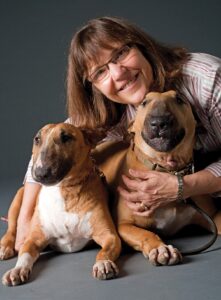-
Adopt
-
Veterinary Care
Services
Client Information
- What to Expect – Angell Boston
- Client Rights and Responsibilities
- Payments / Financial Assistance
- Pharmacy
- Client Policies
- Our Doctors
- Grief Support / Counseling
- Directions and Parking
- Helpful “How-to” Pet Care
Online Payments
Emergency: Boston
Emergency: Waltham
Poison Control Hotline
-
Programs & Resources
- Careers
-
Donate Now
 Terri Bright, Ph. D., BCBA-D, CAAB
Terri Bright, Ph. D., BCBA-D, CAAB
Director of Behavior Services, MSPCA-Angell
617/522-5055 x 5297
behavior@angell.org
If you were to attend a training class at the MSPCA-Angell, you would hear staccato noises going off all over the room. That is the sound of a “clicker,” a little plastic box that is used for training all manner of animals, even people. The clicker is a tool used in what is known as “operant” training, whereby new behavior is shaped using positive reinforcement. Positive reinforcement means that after a behavior, something is added that causes that behavior to happen again. So, if you say “Sit” to a dog, and they sit, and you give them a food treat, and sitting increases in the future, the food was a reinforcer. To increase behavior, the right reinforcer is needed; though your dog may sit for Cheerios in your kitchen, in a training class, you probably need little pieces of meat or cheese to keep their attention.
 If the food is a reinforcer, what’s with the clicker? In the 1940’s, B.F. Skinner’s grad students, Marian and Keller Breland, used children’s toy “crickets” to train first pigeons, then all manner of animals. They taught the animals that the click meant “Food is coming,” by pairing it with food. The click then acted as a “bridge” to the reinforcer. Popularized by Karen Pryor in 1993, “clicker training” became the preferred method of training for modern, rewards-based dog trainers, and it is now used with all species of zoo and marine animals, people, even cats!
If the food is a reinforcer, what’s with the clicker? In the 1940’s, B.F. Skinner’s grad students, Marian and Keller Breland, used children’s toy “crickets” to train first pigeons, then all manner of animals. They taught the animals that the click meant “Food is coming,” by pairing it with food. The click then acted as a “bridge” to the reinforcer. Popularized by Karen Pryor in 1993, “clicker training” became the preferred method of training for modern, rewards-based dog trainers, and it is now used with all species of zoo and marine animals, people, even cats!
The clicker is easy to use. Cut up some pea-sized treats the pet loves. (For cats, use cat treats or a dab of wet food on a spoon.) Click-feed (C-F- it’s alphabetical) 10-20 times or so, until your dog or cat startles in anticipation a little when they hear the click. Then, try training your pet to exhibit this very useful behavior ‑ that of being on a mat. To train for this, set down a bathmat for a dog or a rug square or washcloth for a cat. When they move to investigate it, click, and give them a treat on the mat. In short, 5-minute sessions (shorter for cats!), click and feed any movement toward or onto the mat. After the short training, put the mat away. Soon they will move right towards the mat when you put it down, and you can then click ‑ feed when they stand, then sit there, and, ultimately, even when they lie there quietly. Bring the mat to vet appointments so they have a comfortable place to hang out and relax, or have them stay on the mat at home during your mealtime or when guests come over.
Here are some general guidelines to remember when you are using the clicker:
- If your dog or cat is afraid of the sound, muffle it against your side, or use a ballpoint pen to click.
- It isn’t a remote! You don’t have to point it at your pet! You do always have to pair the click with food, to keep the association (the bridge) strong.
- Do not click to make your dog or cat come to you. Remember, what they are doing at the moment you click is what you are reinforcing. So if your dog is digging a hole in the garden and you click to make them come and look for a treat, you are rewarding digging.
- If you are training a lot with the clicker, use your pet’s daily food for training, and save the high-value food for training or socialization classes, or for times when there are a lot of distractions.
- Can you still reward behavior if you don’t have a clicker? Just use a short marker word (“Yes!” or “Good!”) that you pair with food.
A great advantage of the clicker is it means the same thing to the animal no matter who uses it, and so is a good training tool for the whole family to use. Academically-trained behaviorists all recognize that the best way to reduce unwanted behavior is to increase alternative behaviors; there is no need to frighten an animal with any sort of aversive training methods. The clicker helps to form a strong human-animal bond, and gets your dog or cat thinking, “Hey, how can I make that clicker go off?” They then spend their time doing what you have trained them to do. Though it seems like magic, it is the simplicity of science. Give it a try!
Further reading:
Pryor, Karen. (2002). Don’t Shoot the Dog. Ringpress Books Ltd.
Yin, Sophia. (2010) How to Behave So Your Dog Behaves. TFH Publications.